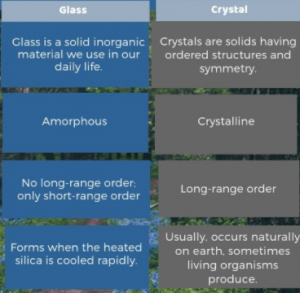Crystal and Glass

The basic difference between crystal and glass is that A crystal for physics is a solid that presents a non-diffuse diffraction pattern, most of the natural crystals are formed by the crystallization of gases under pressure while the glass is an inorganic, brittle, hard, and amorphous ceramic material, it is made up of silica sand, limestone and sodium carbonate fused at 1500 ºC.
Crystal
Crystals are the solid-state with a well-defined, non-diffuse diffraction pattern. Natural crystals are formed from the crystallization of gases under pressure in rock cavities. Its quality, size, color, and shape will depend on the pressure and composition of the gases in these cavities.
The crystals have a regular geometry. Crystals are formed by the union of particles arranged in a regular way following a certain scheme creating a three-dimensional network. Its atoms and ions are organized symmetrically in elementary networks.
Crystals can be solid, luminous, ionic, covalent, molecular, and metallic.
Glass
Glass is a fragile, hard, transparent, and amorphous inorganic material that can be found in nature and can be produced by humans to make windows, lenses, bottles, and various products. It is an amorphous ceramic material.
It is obtained at 1500 ºC from silica, sodium carbonate, and limestone.
Obsidian is a type of natural glass, it comes from molten minerals that were not recrystallized when they cooled after its eruption.
Differences between crystal and glass
- Glass is a ceramic material. It is an amorphous, inorganic, hard, transparent, and brittle solid. It is composed of silica sand, limestone, and sodium carbonate.
- Crystals are regular geometric formations and are formed in nature. Human-made ones contain lead oxide to give it shine and sound and is used in goblets and glasses.